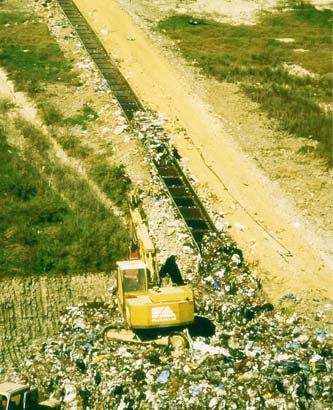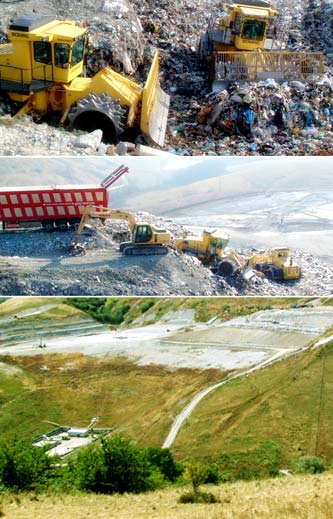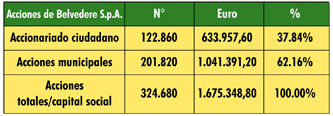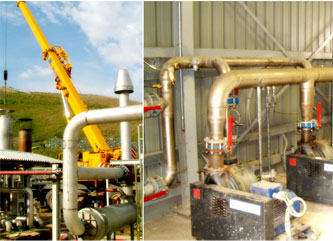 COUNTRY OF ORIGIN
COUNTRY OF ORIGIN• Italy
Community stakeholding, for managing local services
Community Stakeholding in practice
Belvedere S.p.A. of Peccioli is an example of the efficient management of a refuse dump that does not have significant impacts on the environment and whose profits are re-invested in the public interest. The company is owned by the municipal authorities and local shareholders, the citizens of Peccioli and Valdera, who make good use of the benefits and revenues that flow from the refuse dump.
Main developmental phases
• Re-organisation and upgrading of the plant in terms of environmental impacts through the increasing of biogas production and the installation of a co-generating plant; production of electricity for sale to Italy’s national electricity provider ENEL; exploitation of the hot water resulting from the production of electricity through a teleheating distribution system in the district of Legoli. Investment in public works to improve the local infrastructure.
• New enterprise start-ups, for which the refuse plant guaranteed the initial demand, necessary for ensuring an economic return on the capital invested.
• Conversion from a mixed public/private company into joint-stock company, using the community stakeholding approach. The shareholders are directly involved in decision-making through general meetings. In 6 years (1997-2003), the new management approach generated a fivefold increase in the initial value of the shareholders’ investment.
• Promotional initiatives for shareholders by Belvedere Spa, such as the Peccioli Card that gives them discounts in some shops and special offers on some purchases. In this phase, the citizen shareholders safeguard the interests of the community, becoming actors for local development.
Resource optimisation through a “public company”
Identifying the specific resource to manage is the first step towards the creation of a public enterprise. It could be an economic activity that is already ongoing, or it could be one with as yet unrealised potential. In the Peccioli case, the starting point was a poorly run rubbish dump, but the method of governance adopted can be applied to other potential resources.
Efficient public management of a refuse disposal plant requires a long-term approach that aims to make a major impact on local development but which needs to develop in gradual steps, the first being optimisation of the specific chosen resource. Decisions on how to make the most of the potential available are made by a joint-stock company with a broad-based shareholder structure, a “public company” in part owned by the local authorities and in part by citizens who have bought shares through a public offering. The share offering is reserved for residents in communities that are near the resource. 
This type of corporate structure ensures collective decision-making as no single shareholder can increase its financial control of the enterprise. In addition, this corporate structure has the objective of redistributing the profits from its operations in the form of higher incomes, investment in local services, and public works to improve the infrastructure. In the Peccioli case, the initial phase was managed by the municipal authorities, which found the funds to commence work on optimising the plant. In the first 6 years, the running of the plant was contracted out by tender to various private companies. In 1997, the mixed public/private company was set up run the plant directly.
In 1990, the Municipality of Peccioli implemented the project to clean up the plant, and to offer waste disposal services to the rest of the region, which was facing a crisis. The first measures to optimise the Peccioli plant were:
• the upgrading of the plant in terms of its environmental impact;
• the quantification of the volume of refuse that the site could handle;
• the planning of measures to expand the plant, on the basis of the potential user catchment.
The project envisaged expanding the site by 45 000 m2, so enabling it to handle 650 000 tonnes of refuse. The positive response from the regional authorities combined with the state funding for municipalities that accept waste disposal plants in their area made it possible to go ahead with the work to improve the environmental conditions and expand the plant.
The operating revenues were used to fund Belvedere’s activities and to create local jobs and development. The subsequent conversion of the company, through community stakeholding, has meant that most of the profits are now re-invested in local services, with a set amount being allocated to fund the municipal authorities’ expenditure. 
The creation of the Belvedere company
The public company is a company with a fragmented shareholding, that is where the ownership is split into small units spread among a large number of shareholders, none of which has a stake of sufficient size to enjoy sole control. Among the shareholders, the public authority holds the majority stake.
The company is run by a board of directors and its policies are agreed upon by the shareholders. The general meeting of the shareholders appoints the company president. Belvedere S.p.A. employs about 30 people directly, and indirectly provides employment for related co-operatives and enterprises.
Belvedere S.p.A. brings together the Municipality and the citizen shareholders, who acquired their stake through two public offerings. The current president, Renzo Macelloni, a former mayor of Peccioli, was appointed by the shareholders. Since 1997, Belvedere has been in charge of all the plant’s operations and related activities. The main operations of Belvedere S.p.A. are:
• running the municipal rubbish dump at Peccioli;
• maintenance and control of the co-generating plant for electricity production;
• the management of some infrastructure;
• cultural activities and activities to promote the development of the economy and services of the Municipality of Peccioli.
Community stakeholding
Stakeholding is an easy form to implement as a way of involving the civil society in corporate management. In the transition phase of the Belvedere company, the municipal authorities, as the majority shareholder, acquired all the shares and scheduled the timing and number of shares to be sold through a number of public offerings. These public offerings of shares were open to all the citizens resident in the municipalities in the catchment area of the refuse disposal plant.
From the outset, the new company Belvedere Spa has enjoyed significant participation by the local citizens in its management, with an initial community stakeholding of 6%. In three years, this involvement resulted in a profit share among the citizen shareholders equivalent to 10% of the annual capital invested. With two public offerings, in 2000 and 2003, the sale of shares in Belvedere S.p.A. was completed. Today, the community stakeholding is in the hands of 740 shareholders, who hold 38% of the share, with the Municipality of Peccioli retaining a majority stake of 62%. The overall investment by the shareholders has been Euro 4 200 000. Of the citizen shareholders, 435 live in the Municipality of Peccioli (almost 10% of the population), while the others live elsewhere in the surrounding province.
Social roots, growth quality and service improvement
The creation of a community-owned public company of this type was not undertaken with the aim of attracting financial resources from the market. The idea was to involve as many citizens as possible in its actual management. The local population’s confidence and interest in the company’s expanding operations stem from the support that the municipal authorities have provided to many enterprise initiatives. The results achieved are mainly due to the public nature of the corporate management, which has re-invested the revenues obtained (exceptional given the size of the communities involved) in projects agreed upon with the local citizens and businesses. 
Although it is only a small-scale example, the rubbish dump at Peccioli shows how a public operator can retain its role as a promoter of development even in the modern market economy. Public management of a local resource such as a rubbish dump has fostered the creation of new enterprises, whose organisation has often copied the community stakeholding model. In sum, Belvedere S.p.A. can be called a community “public company”.
DOWNLOAD THE BROCHURE PDF
english (0.8 MB)spanish (0.8 MB)
ONLY TEXT
•Community Stakeholding in practice







